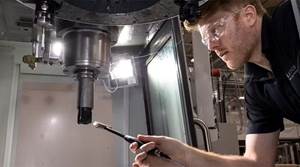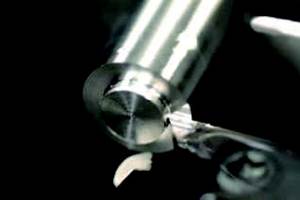Collet Blocks: Hydraulic or Pneumatic?
Collet-style workholding devices, such as collet blocks, offer a number of benefits, but which style is most appropriate for a given application?
Share





Collet-style workholding devices, such as collet blocks, offer a number of benefits. Collets automatically center workpieces, an action that reduces setup time by making their center points known locations. Unlike standard vises or three-jaw chucks that provide minimal points of contact with a part, collets provide equal gripping pressure around a part’s entire circumference. Expanding collet systems are also available to enable internal gripping of thin-wall parts or delicate materials that might otherwise become distorted using other workholding methods.
Grouping collet blocks together can enable equipment such as VMCs, HMCs and jig grinders to machine multiple workpieces unattended over long stretches of time. Collet blocks can be oriented horizontally or vertically and can be installed on workholding devices including tombstones, angled fixture plates and rotary trunnion tables. Hardinge, an Elmira, N.Y. manufacturer of machine tools and workholding equipment, offers several collet block models that use standard-sized collets commonly found in many shops, as well as hex-, square- and custom-shaped collets that can hold various non-round workpieces.
The question then becomes: Which style of collet blocks—hydraulically or pneumatically actuated—is most appropriate for a given machining application?
Even though pneumatically actuated collet blocks provide lower clamping force than hydraulic units, many shops prefer to use pneumatic collet blocks because compressed air is often readily available, easy to connect and doesn’t require complex plumbing schemes. In fact, a small, individual air compressor will do the job, although filtered air is recommended.
A simple pneumatic arrangement consists of a subplate onto which the collet blocks mount and a control valve(s) for part clamping/unclamping. Depending on application requirements, a single air valve can be used to clamp and unclamp all parts simultaneously or multiple valves can be installed to independently control individual collet blocks or rows of blocks. Select Hardinge collet block models enable users to internally plumb units together using connector bushings. Models that don’t use connector bushings must be plumbed externally.
Hydraulically actuated collet blocks require a hydraulic source, but provide higher clamping forces needed for heavy rotation, tapping, threading or off-center machining work. Hardinge says it offers an inexpensive, air-over-hydraulic pump with accessories for shops that don’t have a hydraulic source at the machine. A single two-position, four-way control valve can be used to clamp/unclamp all parts simultaneously. It is also possible to configure multiple valves to control each block or row independently. The control valve(s) mounts on the subplate near the collet blocks and is plumbed to a hydraulic pump located outside the machine.
An optional quick-disconnect system is available for hydraulically actuated collet blocks. This option enables easy preloading of collet blocks with workpieces. Using a quick-disconnect handle with a standard collet block manifold facilitates quick setups because the collet block subplate and pump assemblies are preset and ready to install as needed. However, the collets in a collet block will not maintain their clamped or unclamped position when removed from the manifold unless a check valve is installed in the manifold. In addition, a three-position, four-way control valve mounted outside the machine is required when using the manifold with a check valve to maintain the clamped or unclamped positions with the hydraulic power source disconnected from the subplate. An accumulator is also recommended because it provides a backup reservoir to maintain system pressure if a leak should occur. Accumulators are available in vertical- or horizontal-mount versions and install on the collet block subplate.
Related Content
How to Mitigate Chatter to Boost Machining Rates
There are usually better solutions to chatter than just reducing the feed rate. Through vibration analysis, the chatter problem can be solved, enabling much higher metal removal rates, better quality and longer tool life.
Read MoreShoulder Milling Cuts Racing Part's Cycle Time By Over 50%
Pairing a shoulder mill with a five-axis machine has cut costs and cycle times for one of TTI Machine’s parts, enabling it to support a niche racing community.
Read MoreToolpath Improves Chip Management for Swiss-Type Lathes
This simple change to a Swiss-type turning machine’s toolpath can dramatically improve its ability to manage chips.
Read MoreShop Reclaims 10,000 Square Feet with Inventory Management System
Intech Athens’ inventory management system, which includes vertical lift modules from Kardex Remstar and tool management software from ZOLLER, has saved the company time, space and money.
Read MoreRead Next
Machine Shop MBA
Making Chips and 91ÊÓƵÍøÕ¾ÎÛ are teaming up for a new podcast series called Machine Shop MBA—designed to help manufacturers measure their success against the industry’s best. Through the lens of the Top Shops benchmarking program, the series explores the KPIs that set high-performing shops apart, from machine utilization and first-pass yield to employee engagement and revenue per employee.
Read MoreLast Chance! 2025 Top Shops Benchmarking Survey Still Open Through April 30
Don’t miss out! 91ÊÓƵÍøÕ¾ÎÛ's Top Shops Benchmarking Survey is still open — but not for long. This is your last chance to a receive free, customized benchmarking report that includes actionable feedback across several shopfloor and business metrics.
Read MoreAMRs Are Moving Into Manufacturing: 4 Considerations for Implementation
AMRs can provide a flexible, easy-to-use automation platform so long as manufacturers choose a suitable task and prepare their facilities.
Read More























